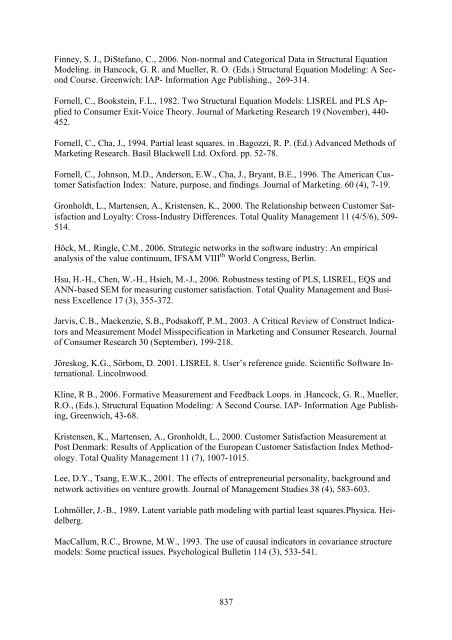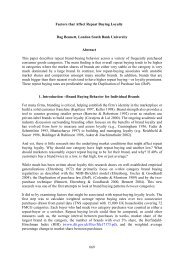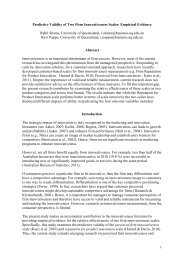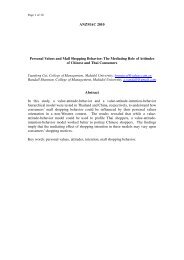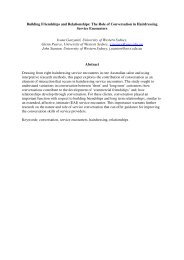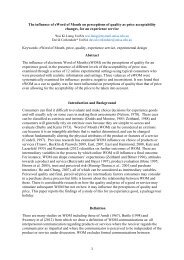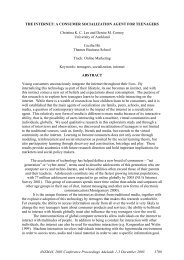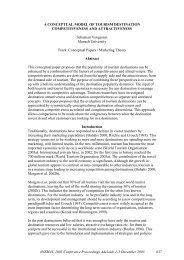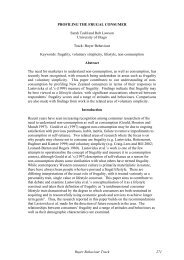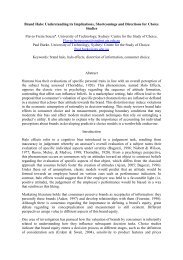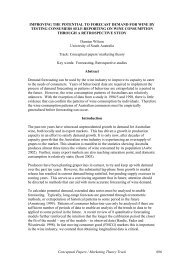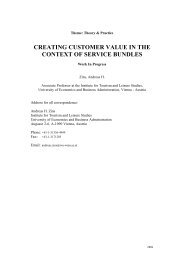Using Structural Equation Modeling for Success Factor ... - ANZMAC
Using Structural Equation Modeling for Success Factor ... - ANZMAC
Using Structural Equation Modeling for Success Factor ... - ANZMAC
You also want an ePaper? Increase the reach of your titles
YUMPU automatically turns print PDFs into web optimized ePapers that Google loves.
Finney, S. J., DiStefano, C., 2006. Non-normal and Categorical Data in <strong>Structural</strong> <strong>Equation</strong><br />
<strong>Modeling</strong>. in Hancock, G. R. and Mueller, R. O. (Eds.) <strong>Structural</strong> <strong>Equation</strong> <strong>Modeling</strong>: A Second<br />
Course. Greenwich: IAP- In<strong>for</strong>mation Age Publishing., 269-314.<br />
Fornell, C., Bookstein, F.L., 1982. Two <strong>Structural</strong> <strong>Equation</strong> Models: LISREL and PLS Applied<br />
to Consumer Exit-Voice Theory. Journal of Marketing Research 19 (November), 440-<br />
452.<br />
Fornell, C., Cha, J., 1994. Partial least squares. in .Bagozzi, R. P. (Ed.) Advanced Methods of<br />
Marketing Research. Basil Blackwell Ltd. Ox<strong>for</strong>d. pp. 52-78.<br />
Fornell, C., Johnson, M.D., Anderson, E.W., Cha, J., Bryant, B.E., 1996. The American Customer<br />
Satisfaction Index: Nature, purpose, and findings. Journal of Marketing. 60 (4), 7-19.<br />
Gronholdt, L., Martensen, A., Kristensen, K., 2000. The Relationship between Customer Satisfaction<br />
and Loyalty: Cross-Industry Differences. Total Quality Management 11 (4/5/6), 509-<br />
514.<br />
Höck, M., Ringle, C.M., 2006. Strategic networks in the software industry: An empirical<br />
analysis of the value continuum, IFSAM VIII th World Congress, Berlin.<br />
Hsu, H.-H., Chen, W.-H., Hsieh, M.-J., 2006. Robustness testing of PLS, LISREL, EQS and<br />
ANN-based SEM <strong>for</strong> measuring customer satisfaction. Total Quality Management and Business<br />
Excellence 17 (3), 355-372.<br />
Jarvis, C.B., Mackenzie, S.B., Podsakoff, P.M., 2003. A Critical Review of Construct Indicators<br />
and Measurement Model Misspecification in Marketing and Consumer Research. Journal<br />
of Consumer Research 30 (September), 199-218.<br />
Jöreskog, K.G., Sörbom, D. 2001. LISREL 8. User’s reference guide. Scientific Software International.<br />
Lincolnwood.<br />
Kline, R B., 2006. Formative Measurement and Feedback Loops. in .Hancock, G. R., Mueller,<br />
R.O., (Eds.), <strong>Structural</strong> <strong>Equation</strong> <strong>Modeling</strong>: A Second Course. IAP- In<strong>for</strong>mation Age Publishing,<br />
Greenwich, 43-68.<br />
Kristensen, K., Martensen, A., Gronholdt, L., 2000. Customer Satisfaction Measurement at<br />
Post Denmark: Results of Application of the European Customer Satisfaction Index Methodology.<br />
Total Quality Management 11 (7), 1007-1015.<br />
Lee, D.Y., Tsang, E.W.K., 2001. The effects of entrepreneurial personality, background and<br />
network activities on venture growth. Journal of Management Studies 38 (4), 583-603.<br />
Lohmöller, J.-B., 1989. Latent variable path modeling with partial least squares.Physica. Heidelberg.<br />
MacCallum, R.C., Browne, M.W., 1993. The use of causal indicators in covariance structure<br />
models: Some practical issues. Psychological Bulletin 114 (3), 533-541.<br />
837


